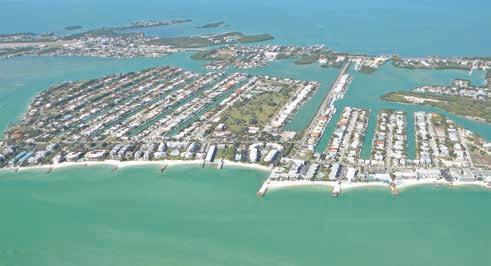
3 minute read
KEY COLONY BEACH COMMISSION APPROVES BUILDING HEIGHT CHANGE
ALEX RICKERT alex@keysweekly.com
Ayearslong point of contention for Key Colony Beach residents came to a close on Jan. 19 as the city commission voted to approve ordinance 2021-469, amending Key Colony’s Land Development Regulations and allowing a maximum height of 40 feet for homes citywide.
The change, which brings zone R-2B –a zone that previously restricted houses along Sadowski Causeway and 7th Street to a single level – into alignment with other areas of the city, is intended to help compliance with flood maps proposed by FEMA and the National Flood Insurance Program (NFIP). But to the KCB residents who spoke against the ordinance at multiple town meetings, including the Jan. 19 final reading, and sent pages of correspondence to the commission, resisting the change was a matter of preserving the city’s community character and addressing potential overcrowding nightmares.
Many expressed concern that with a host of existing homes constructed as duplexes on narrow 40-foot-wide lots, the change could bring about a boom in maxed-out stilted two-story vacation rental construction on the packed streets.
Key Colony’s existing ordinance caps vacation rentals at 10 occupants.
“The fear is that a two-level duplex is built, with the square footage to technically allow 10 persons per side, for a total of 20 people on one property,” attorney Stefanie Burford wrote to the commission in a Jan. 4 email. “I ask that the height be less than 40 feet, but FEMA compliant, if possible. … (And) only allow one level of living.”
Numerous other emails and letters echoed Burford’s request for a single level of living and decried the ordinance’s potential impacts on traffic and parking concerns, arguing that a maximum height of 34 feet would allow for a balance between flood concerns and preservation of the streets’ character.
“The quality of life for the residents will be reduced in terms of vista, noise, traffic and the sharp and rapid shift of culture from residing to renting,” residents David and Beverly McKeehan told
New ordinance allows elevated multistory structures on Sadowski Causeway and 7th Street
the commission on Jan. 3. “The possibility of eight bedrooms and 4,000 square feet under air in KCB as stacked duplex rental units has the attention of developers and rental agents around the state. We have been receiving repeated and unsolicited text messages from someone named Dave at Vacasa in Jacksonville.”
“I think (residents opposed to the change) don’t see the correlation between going to two stories and a safety issue,” said commissioner Joey Raspe. “I think it’s very realistic that (investors) will come in and buy two of these groundlevel homes knowing they can put 10 people in each side as a rental, take the whole unit, and (demolish it).”
However, as some commissioners and proponents of the change pointed out, modifications to land development regulations to account for sea level rise are a no-brainer, and passing new ordinances allowing different property rights in separate areas of the city could wade into dicey legal waters. As with other Keys municipalities, Key Colony Beach’s ability to further restrict vacation rentals is all but nullified by state statutes.
“We cannot be strong-armed by the wishes of a few; all rules should be applied fairly and equally to all,” wrote Ernesto Perez, a Sadowski Causeway resident, on Jan. 5. “While the property values of some are going up, those that live in R-2B are at risk of devaluing and losing their resale value. … I would not doubt that some may take legal action against the city as a result.”
“I would like to say on the record that it’s not that I am pro-vacation rentals. I am not for development, necessarily, in a lot of aspects,” Mayor Patti Trefry told residents gathered at the Jan. 19 meeting. “But as far as development in the city, the state has tied our hands. Simple as that.”
Trefry and commissioner Tom Harding both expressed their obligation to protect property rights equally across the city as the driving factors behind their eventual votes.
“(The maximum height increase) is consistent with what has been done throughout the county,” vice mayor Beth Ramsay-Vickrey told the Weekly after the meeting. “At the end of the day, this came down to being a legal issue.
“Based on Florida Chapter 70 language, I had great concern, which I discussed with (City Attorney Dirk Smits), that restricting these R-2B properties while we took the rest of our city to 40 feet would have resulted in a legal finding of ‘unfair and disproportionate zoning.’ As much as I sympathize with those on 7th Street who objected, and I truly do understand and sympathize with them, I simply could not vote to put our city into what would, most likely, have resulted in a losing lawsuit.”
The commission voted 4-1 to approve the ordinance, with Raspe as the lone nay vote.




ALEX RICKERT alex@keysweekly.com
DAVID MANZ HONORED WITH FLORIDA BAR PRO BONO AWARD










